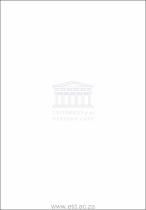| dc.contributor.advisor | Jovanovic, Nebo | |
| dc.contributor.author | Samuels, Donovan | |
| dc.date.accessioned | 2022-03-09T10:32:00Z | |
| dc.date.available | 2022-03-09T10:32:00Z | |
| dc.date.issued | 2007 | |
| dc.identifier.uri | http://hdl.handle.net/11394/8866 | |
| dc.description | >Magister Scientiae - MSc | en_US |
| dc.description.abstract | Aquifer vulnerability assessment is increasingly becoming a very significant basis in order to fulfil the water demands in South Africa. Knowledge of soil hydraulic properties that consists of the soil water retention and hydraulic conductivity functions is a prerequisite for predicting solution transport in soils. The overall objective of the study is to develop a database of hydraulic properties for collected undisturbed samples and to test selected models by making use of this database. Studies of the vadose zone are generally restricted to the top 1.2 meters; therefore this study aims at essentially improving the lack of measurements and modelling in the vadose zone. There exist several methods to determine hydraulic properties of soil that make use of hydraulic conductivity (K) determination in the vadose zone. The most accurate estimates of hydraulic conductivity are possible through direct measurements or measurements of the water retention curve. For this study, the drilling and sampling of five boreholes (maximum depth 20 m) proceeded during March and April 2005 at two typical
sites in the Western Cape, namely the Berg river site (Riebeek West) and Ithemba site (Cape Flats). In total, 76 undisturbed core samples were collected from which the detailed borehole log descriptions were made. The determination of the soil water retention curves of the collected samples was based on laboratory techniques using Eijkelkamp drying and suction equipment (sand box and clay box). When modelling groundwater vulnerability, it is essential to look at the soil water retention curves with increased importance, as they provide graphical and
mathematical confirmation of porosity, preferential flows, volumetric water content and unsaturated hydraulic conductivity. Therefore, a numerical model called RETC was used to determine soil hydraulic properties. The RETC model uses equations of Van Genuchten (Van Genuchten, 1980) and Brooks-Corey (Brooks and Corey, 1966) to determine parameters for soil water retention and the methods of Mualem (1976) and Burdine (1953) to determine unsaturated hydraulic conductivity functions. Saturated hydraulic conductivity values were
estimated by using RETC soil database based on textural descriptions of collected samples. Using the soil hydraulic estimates obtained from RETC, sensitivity analyses were run with a one dimensional transport model, Macro 5.0 for two sites at iThemba and in the Berg river. | en_US |
| dc.language.iso | en | en_US |
| dc.publisher | University of the Western Cape | en_US |
| dc.subject | Groundwater vulnerability | en_US |
| dc.subject | Hydraulic properties | en_US |
| dc.subject | MACRO 5.0 | en_US |
| dc.subject | RETC | en_US |
| dc.subject | Soil water retention curve | en_US |
| dc.subject | Vadose zone | en_US |
| dc.title | Hydraulic properties of the vadose zone at two typical sites in the Western Cape for the assessment of groundwater vulnerabilitv to pollution | en_US |
| dc.rights.holder | University of the Western Cape | en_US |

